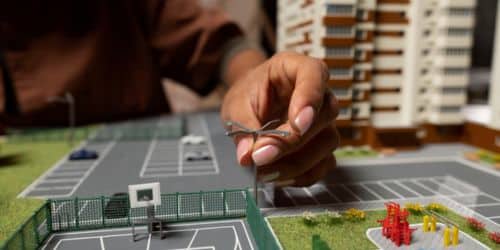Community development projects can help build a local community in a variety of ways. Community development projects can take several forms, such as those focused on assisting certain sectors of the community, improving safety conditions, and increasing social and cultural pursuits throughout the region. Foundations and local governments may help their towns and cities flourish sustainably by funding specific community development projects.
What Is A Community Development Project?
A community development project is one of several approaches to strengthening a local community. Community development projects can take several forms, such as those focused on supporting certain parts of the community, improving safety conditions, and increasing social and cultural interests in a given location.
Community development aims to provide individuals and groups with the skills necessary to affect change in their communities. These abilities are frequently developed through the establishment of social groups working toward a similar goal. As a community developer or planner who takes an entrepreneurial approach, you must understand how to engage with individuals as well as how to influence community positions within the framework of broader social organizations.
How to Assess a Community Development Project
When assessing the potential of a development project to help a community, you must analyze the actual need for the work that you wish to perform. In other words, you should try to assess the need you are aiming to fill.
Conduct qualitative study on available community resources. You most likely do not want to start a project that duplicates the work of another community group. If you want to build a housing development for low-income families, for example, you should think about the availability of similar housing options in your town. Similarly, if you are planning a garden, consider the closeness of existing gardens as well as the overall interest of community members in having access to a gardening site.
Next, assess the viability of your desired outcome. Consider the necessary financial resources, potential collaborators, and continuing operating logistics. Determine whether you can rely on volunteer labor or if you need to produce enough funds to pay employees.
Starting a Community Development Project
When you’ve discovered particular ways in which underrepresented individuals of your community are currently underserved, or a significant need in your community that isn’t being met at all, you’ll need to identify allies to help you carry out your goal. Consider looking for a nonprofit organization whose objective is similar to your project aims. If you are unable to combine your efforts with an existing organization, you may choose to try forming your own.
Many, but not all, states have Community Development Corporation affiliations. Their instructions are largely concerned with the provision and preservation of affordable housing, homelessness prevention measures such as Housing First, and the development of green space. Find out if your area has a certified Community Development Corporation that is doing the type of job you want to establish.
It is possible to create your own CDC, but you must first establish a 501(c&(3) nonprofit business. Working closely with a state or city’s department of community development and accessing federal financing sources with restricted availability may be possible if you have CDC designation. However, keep in mind that the procedure of establishing a CDC differs widely different jurisdictions and can be time-consuming. However, initiating the procedure early in the creation of your project may become useful later on in the course of your project’s advancement.
It may be beneficial to speak with people who work in the relevant department of your city or municipality. They can guide you in the correct direction in terms of who is doing comparable work and what kind of assistance their department may be able to provide.
How to Start a Community Development Project
Funding for a community initiative will be required from foundations, individual contributors, or government grant sources. Federal, state, and local grants are all available. Keep an eye out for news of funding availability on a regular basis. NOFAs are requests for proposals that allow NGOs to submit applications for a certain amount of funds and a detailed description of how they intend to spend it.
You may also be able to find in-kind donations, which are non-monetary offerings. Some local businesses may have corporate giving initiatives that distribute service donations. Be aware that, in addition to federal nonprofit status, soliciting gifts in your state may necessitate obtaining a formal certificate of solicitation from the state.
Every sort of sponsor appreciates it when a project collaborates with organizations that work in the same field but do different things. Signing a memorandum of understanding to collaborate with other organizations can considerably boost applications. A housing complex for chronically homeless people, for example, may consider forming MOAs with nearby shelters to get housing recommendations.
Funders also want to see evidence of community support for a project. A letter of support from a neighborhood group for a housing project can be a huge help in getting the project started. Funders prefer to see engagement in addition to assistance. Plan how you will recruit volunteers from your neighborhood.
Finally, funders want to know that you are maximizing your resources. In fact, a number of foundation RFPs and government NOFAs require you to donate more than 100% of the money or goods requested in your proposal.
Community Development Project Ideas To Implement
As the coronavirus pandemic moves out of crisis mode, it’s time for your community groups to move forward. If the circumstances call for it, restart face-to-face meetings, preferably outside if possible. Zoom conversations are not suitable for meeting new individuals or organizations since too much verbal detail is lost, but video conferences can speed up internal planning when participants are acclimated to working together. Here are some ideas to get you started.
Idea #1.
Start a farmer’s market that takes place at least once a week when local product is in season. You may have a winter market once a month or more frequently. If this is overdone and tired in your community, attempt a cook’s market with fresh bread, handmade rolling pins, locally created ceramic garlic jars, and whatever else interesting and local you can find.
Idea #2.
Determine what makes your city, street, or neighborhood unique, and then plan how to afford some street banners. Your utility company may provide advice on the optimum size, shape, and kind, as well as assistance in hanging them. Local graphic designers frequently give some of their design work. To support their production, seek a small grant or launch a crowdfunding campaign.
Idea #3.
Create a tool library for homeowners who may not have all of the tools needed to maintain or upgrade average homes in your area. It should function similarly to a public library, with users signing up for free memberships, providing all of their contact information, and then borrowing tools for a set length of time. Enlist the help of a nonprofit, community development corporation, government office, or congregation to manage the tool library.
Idea #4.
Consider some low-cost water elements like bubbler fountains. You might be able to include an interesting collection of local pebbles or even metalwork into the design. A high school artist or an aspiring high school artist can assist you with the design, which does not have to be perfect. In fact, the irregularity is a benefit of this style of fountain, which is also cost effective to operate.
Idea #5.
Organize a walk audit in collaboration with the police, groups that serve children and the elderly, and retail companies that rely on street traffic. Plan a route that will allow participants to discuss walking deterrents such as speeding vehicles, inadequate or missing sidewalks, a lack of traffic lights and crosswalks, difficult grates or culverts, a sense of safety in the neighborhood, a lack of shade and resting places, and bleak surroundings.
Idea #6.
Create some visually appealing code enforcement process diagrams to describe the “who,” “what,” “when,” and “why” of code enforcement in your municipality. Try to get your explainers to every home, either by including them in a community newsletter or by tying a flyer to doorknobs. If your city is cooperative, you may want to give some statistics about the number of tickets issued for various sorts of infractions and the number of successful code violations resolved.
Idea #7.
Organize a Renter’s Eye View tour for city officials and anybody else who is interested. Visit the rental apartments and homes, question the landlords about the rental market, and then get together to discuss what you’ve learned about how the more transitory, older, or impoverished prospective inhabitants perceive your community. Following that, tenants’ housing conditions, rental costs, and involvement in neighborhood issues can be explored.
Idea #8.
Reframe your most difficult issue as a campaign to be the best neighborhood or town in a given quality. Enlist marketing or even straight advertising experts to help you figure out how to position the campaign, but also find the most blunt, goal-oriented city improvement experts possible from local universities, nonprofits, nearby planning departments, or planning consulting firms to advise you on making the solutions real rather than just perceived.
Idea #9.
Experiment with forming or developing a coalition to handle a single continuing issue or difficulty. Even the most prosperous areas face at least one challenge: too much success, which drives people out. Create a six-month plan for reaching out to possible new partners.
Idea #10.
Increase your social media profile by increasing the amount of posts or platforms you use. If board members in your neighborhood association or business organization are challenged to come up with a new concept, information, or photo every week, it isn’t as difficult as you think. After a few weeks or months, certain posts can be recycled. Then simply find a bright adolescent, college student, or other volunteer to create the posts. Make a policy outlining who publishes, how postings are accepted, and rules for themes, views, or tone.
Idea #11.
If you have an issue with a huge house or a tiny empty facility, such as a lodge of a now-defunct fraternal organization, look into how restoring those buildings could lead to your neighborhood or town being a wedding destination or other special event venue.
Idea #12.
Create or incentivize the establishment of at least one coworking space in your area. Some of you will have a coffee shop that works as a de facto coworking space, but we bet there is no formal networking among folks who frequent a specific coffee shop. Coworking is more than just a space to work away from home or a formal office; it also entails the sharing of facilities and, in most cases, ideas and services. Such locations attract community-minded entrepreneurs, who are ultimately more successful in business.
Idea #13.
Create a means to highlight the limits of your neighborhood or district, or to proclaim the entrance to your area along other edges such as streams, rivers, or roads.
Idea #14.
Experiment with different parking cost structures to see what occurs. Can you afford to de-commission those parking meters and allow free parking if local businesses rigorously prohibit their employees from parking on the street, for example? If you have pay parking lots or garages, does lowering the cost result in more patronage for local businesses, or does it make a difference? If parking is scarce, does raising the price help to increase parking space availability, and if yes, how does this adjustment affect consumer support for your local businesses?
Idea #15.
If your neighborhood has even one coffee shop, folk music venue, bar that occasionally has live music, or nightclub, see if you can create an open mic night that other businesses in your neighborhood will promote. More often than not, the business owner will be open to this proposal because it will bring in new consumers and change up the routine enough for regulars to return more frequently. We recommend testing it for four weeks in a row to evaluate if it has a beneficial impact on other companies and creates a buzz in your town. Check to see if it grows from week to week. If not, proceed to the next suggestion.
Idea #16.
Put together a vacant property effort if you live in an area where there are more unoccupied residential or commercial spaces than you believe is required to provide a healthy range of options for newcomers. Organize coffees or tours for real estate agents and key persons in the community to draw attention to the opportunities provided by your vacancy. Put up eye-catching posters and displays in abandoned businesses, and make sure vacant dwellings are well-kept and have some color from low-cost flowering plants. Include local bankers if finance is an issue. If your issue is chronic and on a large scale, your first agenda item could be to try to pass an empty property registration law.
Idea #17.
Concentrate on finding a strategy to give summer employment for local youngsters. Your county or state government may be able to assist with the expenditures. We propose a summer job continuum, beginning with a low number of daily or weekly hours for the youngest persons permitted to work under your state’s laws, and gradually increasing both the number of hours permitted and the hourly wage as youth age increases. If these employment may provide an entry point into careers with local firms, all the better.
Project Plan for Community Development
A community development project that takes an entrepreneurial approach can provide socioeconomic benefits to a community by providing jobs, expanding access to goods and services, and producing revenue for residents. You can write a project plan by following these steps:
#1. Identify the community’s needs
Begin by doing a needs assessment to understand the community’s difficulties and potential. This could include interviews with members of the community, focus groups, or surveys.
#2. Outline the project’s goals and objectives
Once you have a good knowledge of the community’s needs, you can outline the project’s goals and objectives. These should be SMART goals: specific, measurable, attainable, relevant, and time-bound.
#3. Create a business plan
A business plan is a detailed document that outlines the business concept, market research, financial predictions, marketing and sales strategy, and so on. Thorough market research is essential for understanding potential demand for your product or service and identifying prospective competitors.
#4. Identify resources and partners
Determine the resources and partners required to carry out the project, such as money sources, volunteers, and local organizations.
#5. Create a budget
Create a budget that specifies the project’s costs, including start-up expenditures, operational expenses, and predicted income.
#6. Make a timeline
Make a timeline outlining the project’s essential activities and milestones. This will help you stay on track and complete the assignment on time.
Share the plan with the community and other stakeholders to gather input and support. Presentations, meetings, and public forums could all fall under this category.
Following these steps will allow you to create a strategy for a community development project that employs an entrepreneurship approach and can provide socioeconomic benefits to the community.
What Makes a Good Community Development Project?
Ensure that the initiative is founded on the community’s values, beliefs, and ideals. Engage the community so that they can feel empowered and contribute to the project’s development. This will take time for the community and other stakeholders. Everyone is aware of these from the outset.
What Are The Roles of Community Development Project?
Community development professionals work with individuals, families, and entire communities to effect social change and improve the quality of life in their community. They serve as a link between communities and a variety of other local government and volunteer sector providers, such as police officers, social workers, and teachers.
- What Is Community Service? Importance Of Community Service In Nigeria
- COMMUNITY RELATIONS: Benefit, Types, and Full Job Description
- Top Reasons And Ways To Support Small Businesses
- Best Platform To Build An Online Community






